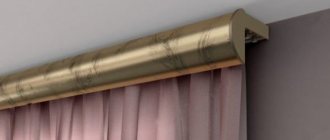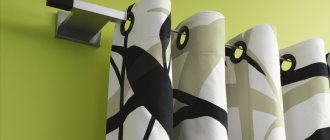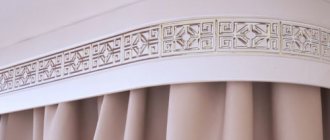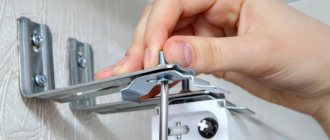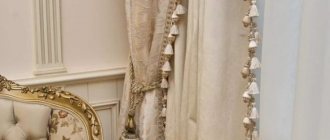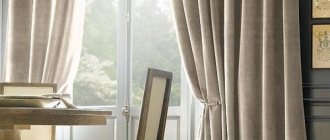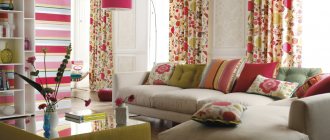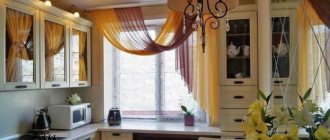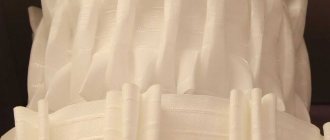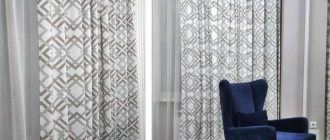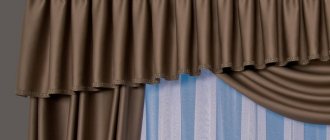The window opening is an important part of the interior. Various design techniques are used to decorate it. However, the most common type of window decoration remains textiles and structures used to fasten the canvas. The choice and installation of curtain rods causes difficulties for many ordinary people. Before purchasing a suitable device, you should solve a number of problems, for example, take into account the correspondence of the appearance of the product to the style of the room, the ability of walls, finishing materials, and the item itself to withstand certain loads.
How to choose a cornice
From a functional point of view, the cornice is intended exclusively for attaching curtains. From an aesthetic point of view, this is an important element that can emphasize the style of the room and focus attention on the window opening. The item has a simple design, which consists of the following parts: a base supporting the curtain (pipe, string, tire); brackets, holders for fixing the base; fasteners for textile fabric; side plugs.
The choice of product should be approached very responsibly. When purchasing a design, you must consider the following points:
- Window size. The length of the cornice should exceed the width of the window opening by 40 cm.
- Load bearing capacity. The item must be strong enough to withstand the load exerted by the curtains.
- Location of batteries, pipes, protruding part of the window sill. These elements should not interfere with the free hanging and movement of the canvas.
- Color spectrum. The shade is selected in accordance with the existing design.
- Size and space. If round models are suitable for framing windows in a room of any size, then string models will look more impressive only in small rooms, and bulky wooden ones are recommended to be installed in large living rooms.
- Number of rows. Depending on the purpose, you can choose one-, two-, three-row designs. The latest models will allow you to decorate a room with complex textile compositions.
- Material. Metal, wood, and plastic are used in the production of products. The choice of the most suitable option depends on the style, price category, and personal preferences of the buyer.
What is important to consider when buying a baguette
Before you figure out how to install a curtain rod on a wall, we’ll tell you what to look for when purchasing a product. There are different designs on the market:
Each of them has its own advantages and disadvantages. They definitely need to be taken into account. But the installation is greatly influenced only by the type of brackets that come with the products. Depending on the material, there are several options:
- Plastic. The cheapest, but the most fragile. They are great for tulles and light curtains. When hanging a heavy canvas, the fastening sags and eventually breaks.
- Wooden. They help bring vivid design solutions to life. Their strength directly depends on the quality of workmanship. Therefore, components must be carefully inspected to ensure there are no knots, chips or cracks.
- Metal. The most reliable and durable curtain rods. If your budget allows, preference should be given to them.
Each option has its own design features. Many of them only affect appearance. But the type of mounting plate determines the reliability of fastening to the wall:
- Three-point. Makes it possible to firmly secure the structure and avoid turning the rod holder. This is ideal for installation in concrete and wood. If the holes are located close to each other, installation in porous materials becomes more difficult: aerated concrete, hollow brick and others. A fragment of the weakened surface may crumble or break off.
- Single point. The only hole for the dowel is in the middle of the installation “cup”. In this case, under the weight of heavy curtains, the bracket may tilt down slightly. But this makes it possible to firmly screw it to a surface made of hollow materials. It is enough to choose a dowel of the desired type and length.
If you have to attach a three-point “cup” to a hollow base, drive the load-bearing dowel only into the upper hole. We screw small self-tapping screws into the other two to avoid turning the bracket.
Features and rules for installing cornices
Assembling and installing any model will not take much time from an experienced craftsman. An amateur who wants to do the work with his own hands will need help. Initially, he needs to take measurements of the window opening, on the basis of which calculations are made. Next, you should familiarize yourself with the rules and features of installation:
- Regardless of the mounting method (ceiling, wall), the length of the structure must be at least 30 cm greater than the width of the window, with the exception of the option when the product is located along the entire wall.
- The distance from the wall to the rod is selected within 10-15 cm. This is quite enough for the curtain to move freely without touching the protruding part of the window sill or the radiator.
- The distance between the cornice and the ceiling is determined individually, but professionals recommend mounting the structure at a distance of 5-10 cm from the ceiling surface.
- Particular attention should be paid to the height at which the device will be mounted above the upper border of the window frame. This parameter must exceed 5-7 cm, otherwise the curtains will interfere with the opening of the window.
Advantages
There are two types of plastic curtain hangers - round and tire-shaped. Ordinary round parts do not stand out in anything special and look like a simple tube with tips on the ends, attached to the wall. They do not have any particular advantages or disadvantages compared to standard metal or wood hangers, except for the difference in price - plastic parts are cheaper. Another thing is plastic wall curtain rods in the form of a tire. They have a certain set of advantages:
- The design is very light.
- The cost of the cornice is low.
- If necessary, installation can be carried out both on the wall and on the ceiling.
- There are one, two and three row models.
- The length of the structure is practically unlimited, since several tires can be connected into one large composition.
- There are corner curved modules that will allow you to assemble a structure with curves.
- The color of the plastic is white and does not stand out against the background of a standard ceiling design.
- If necessary, you can decorate the outside of the product using a special decorative tape.
- Installing the suspension is no more difficult than installing standard rods.
- Caring for the product is very easy, thanks to its water resistance.
The only disadvantage of such tires is the restriction on the weight of the fabric used to make curtains. However, a plastic tire can easily withstand most modern curtains.
Methods and choice of fastening
Depending on the installation method, a distinction is made between ceiling and wall cornices. In the first case, some models can be mounted directly to the ceiling or using brackets. In the second option, the products can only be mounted on supporting cantilever structures. Dowel-nails, self-tapping screws, liquid nails, drywall dowels, and anchor bolts are used as fasteners.
The choice of fasteners depends on various factors. First of all, the material of the walls and ceiling is taken into account. For example, for fragile partitions made of foam blocks, special expansion anchor bolts are used. For brick walls, or those built from durable concrete, you can use any type of fasteners. In red brick, which tends to chip, wood caps are often used.
It is worth paying attention to the raw materials from which the cornice is made, its weight, and the load it places on the partitions. In some cases, you will have to use additional fasteners or even abandon massive wooden or metal products in favor of lighter plastic or aluminum ones.
The bracket can be securely fixed on a wooden or concrete base. When installing the structure on a suspended ceiling or plasterboard, the presence of mortgages should be provided in advance.
How to attach the bracket to the wall?
Schemes for installing a profile cornice to the wall
The procedure for attaching to the wall (as well as to the ceiling) is the same in all cases. The only difference is the choice of fastening elements, which in turn depends on the wall material.
Installation of profile cornices to the ceiling
This is what material the wall can be made of.
- Brick.
- Cinder blocks.
- Gas silicate blocks.
- Reinforced concrete slabs.
- Wooden beam.
- Plasterboard cladding.
- Layer of plaster.
The last two points, of course, cannot be present in the apartment as an independent wall material. But as a finishing layer - easily. When installing a hanger for window textiles on a wall, the best base for mounting is wood, concrete or its derivatives. In the presence of drywall or an impressive layer of plaster, the inexperienced layman has to be puzzled.
For mounting brackets to a brick or concrete base, ordinary dowel-nails are suitable. The diameter of the fastener, as well as its quantity, is selected based on the weight of the product and the textiles on it. Accordingly, the higher the weight, the larger the diameter of the dowels you will have to buy. For “particularly severe cases” you may even need anchor bolts. They are made of metal, so they carry high loads.
Installing a ceiling cornice to a concrete ceiling
Anchors must be installed for large curtain formats. For example, Japanese sliding structures for panoramic windows have an impressive weight due to their steel base, as well as an automatic sliding drive. In this case, you cannot do without high-quality fasteners.
But ordinary dowels are not suitable for plasterboard sheets. Here you will have to buy special drop-down fasteners. A butterfly dowel works great. Thanks to the increased fixation plane, the gypsum board does not deform under significant loads. But for heavy objects you will still have to use the same anchors. In this case, the order of work is as follows:
- a sheet of drywall is drilled with a wood or metal drill to the base of the wall;
- after a complete passage of the drywall, the main wall is drilled with a drill in stone or concrete to the size of the anchor;
- the entire structure is secured through a bracket into a metal dowel.
Be sure to keep in mind that the anchor must extend into the concrete wall to its full possible length. With this method, the reliability of the structure will be high.
The most unpleasant case is the presence of a thick layer of old plaster, which also crumbles at the touch of a finger. It is very problematic to secure anything in such a wall, not to mention a heavy curtain. Here you have two options.
- Use an anchor in the base of the wall.
- Strengthen the plaster layer with special compounds.
If you are going to hang one light tulle in the kitchen, there is no need to drill the wall to the brick. Do the following:
- drill a hole of a larger diameter for the dowel (2-3 mm);
- insert the dowel, filling the voids with liquid nails;
- let the mixture harden;
- attach the bracket.
This is a very reliable method of fixing the suspension in a loose layer of plaster.
But if we are talking about the full design of a window opening (lambrequin, curtain, etc.), then only anchors will help here. The procedure is the same as for installation in drywall. Upon completion of installation, gaps in the plaster must be filled with cement mortar or tile adhesive.
Scheme for attaching a cornice to a suspended ceiling
Installation of ceiling cornices
Ceiling models are very popular. They can be hung in almost any place, even placed in niches. These products are preferred in the following cases:
- if necessary, hang long curtains from the ceiling;
- if it is impossible to securely fix the brackets on the wall;
- to close the panoramic window;
- to hide minor finishing defects;
- the distance between the top of the window opening and the ceiling is so small that there is no possibility of mounting wall-mounted options.
Even a beginner in the construction business can carry out installation work. The main thing is to adhere to all the rules and recommendations, follow the instructions. The experience gained in this way will help in the future to correctly connect all the elements and install similar structures without any problems.
Materials and tools
Before starting work, you should prepare everything you need. This will allow you not to be distracted from work by searching for missing components or consumables. To perform installation you will need:
- curtain supporting base, brackets, caps or decorative ends;
- curtain rings or hooks;
- fasteners;
- measuring instruments, level, pencil;
- ladder;
- drill or hammer drill;
- screwdriver, screwdriver;
- hammer;
- hacksaw;
- drill.
Installation procedure
The order of work, as well as its type, directly depends on the type of cornice chosen. The profile structures can be fixed directly to the ceiling using brackets. Let's consider the option of attaching a plastic tire box to a concrete floor:
- We take measurements of the window opening.
- Following all the rules, we make markings on the ceiling.
- If the product is longer than the measurements taken, cut it using a hacksaw.
- We drill mounting holes in the plastic box, which should be located in the spaces between the tracks. To do this you will need two drills of different diameters. We make the first hole in the middle, the rest at the same distance from it. Their number directly depends on the expected load.
- Using a drill whose diameter exceeds the screw head, we make a hole on the front of the box.
- Using the second drill, which matches the diameter of the fastener rod, we drill a hole in the rear wall.
- We apply the box to the ceiling, starting from the center, set marks at the place where the dowels are attached, and drill holes in the concrete.
- We hammer in the dowels.
Work on mistakes
What to do if mistakes were made when choosing or calculating the mounting locations for the cornice? The main thing is not to rush to despair and get upset. Let's look at two of the most common mistakes made by beginners.
The problem of a cornice that is too long can be solved with the help of a hacksaw; the only limitation is the presence of decorative elements; there is a high probability that the cornice will lose its visual appeal.
If the cornice turns out to be too small or the standard models are not suitable for a long wall, you will have to go in search of special connecting elements that will easily allow the main length to join the additional one without disturbing the movement of the hook-runners.
Installation of wall cornices
Models mounted on walls have a wider application. They are compatible with interior design made in any style. Unlike ceiling options, these structures are much easier to install yourself. For clarity, let’s look at how to install the main types, which include:
- round;
- strings;
- profile;
- baguette
Each type has its own installation features. However, all of the above types are mounted using brackets. The main stages of the work are almost identical, as can be seen from the examples given in the instructions.
Baguette
The main difference between baguette cornices is the presence of a decorative strip that hides all structural elements. Based on the type of base used for attaching curtains, rod, string, and rail models are distinguished. The procedure for installing a baguette with a plastic tire:
- We mark the wall according to the level.
- We drill holes with a hammer drill and insert dowels into them.
- We install the brackets and securely fix them with self-tapping screws.
- According to the existing diagram, we assemble the workpiece and connect the tire to the decorative strip.
- We fix the resulting workpiece to the brackets.
- Upon completion of installation, you can hang curtains and tulle on the finished product.
String
The main feature of string models is their special structure. They consist of steel threads, brackets, and hooks. The length of the string should not exceed five meters; it can be hung in several rows. However, it is worth considering that only light textiles can be hung on a thin thread. The structure will not support the weight of heavy curtains. Installing these curtain rods should not cause difficulties even for an inexperienced person; the process itself is as follows:
- We determine the location for fastening and carry out markings according to the level.
- After attaching the fasteners, we make a mark for the dowel.
- We drill holes and install fasteners.
- Through the hole in the installed mount, we insert a steel string into the first bracket.
- We distribute hooks or rings along the thread.
- We pass the string through the second string bracket and adjust the required tension using a special bolt.
- We cut off the excess steel thread, you can also roll it, this will allow you to lengthen the product in the future.
Rod
Round cornices, in which the rod is the main element, are classic models. Special caps or decorative tips are attached to the edges of the product. They act as decoration and do not allow the rings to come off the pipe. When choosing such options, you should pay attention to their parameters. Short structures can be fixed on two brackets, but if their length exceeds 1.5 m, then additional fasteners should be provided, which are installed in the center. Installation work is carried out according to the following scheme:
- We measure the width of the window.
- We make markings according to the level.
- We unscrew the heel from the holder, try it on the wall, and mark with a pencil the places for the dowels.
- When installing long products, we make an additional mark in the middle of the window opening.
- Using an electric drill, we drill holes in the intended location and hammer dowels into them.
- Using self-tapping screws, screw the heels to the wall.
- We screw the base of the holder onto the heels.
- We assemble the structure, put on the required number of rings, and install plugs on the sides.
- When installing, first fix the central bracket, then the side fasteners.
- At the final stage we hang the curtains.
Profile
Profile models look appropriate in any interior. They are made from plastic or aluminum. The maximum length does not exceed 6 m, however, if necessary, this parameter can be increased using connecting parts. Some products are capable of bending in two planes at any angle, which allows them to be used to design window openings of any fancy shape. For clarity, let’s look at the step-by-step instructions for installing the structure:
- We determine the installation location.
- We make markings along the entire length with a pencil.
- If a long structure is being installed, it is necessary to provide more than two brackets, especially at bend points.
- Often profile curtain rods are sold without holders, so they will have to be purchased separately.
- We drill holes and install brackets.
- We fix the profile on the fasteners.
Assembling the curtain before installation
Installation instructions for metal cornice with decorative elements
Before hanging the curtain rod on the wall, it must be completely assembled on the floor. The most common design is a direct suspension, consisting of:
- metal guide (crossbar);
- brackets;
- rings or clothespins for securing curtains;
- stubs;
- decorative body kits;
- fasteners
Rings and clothespins may be missing. Instead, loops are sewn onto each curtain, tulle or lambrequin through which the crossbar is threaded.
First, rings (if any) are put on the crossbar. Then the brackets are attached. The location of the latter depends on the manufacturer of the product. Some companies include compatible grooves in the brackets and crossbars, allowing you to easily attach the two elements together. Other models are fixed in an arbitrary place. In both cases, fastening is carried out using special bolts.
After installing the bracket, they proceed to installing the plugs and decorative components of the suspension. Most often, decorations are made in the form of metal forging and wood carving. For ease of installation, they are combined with plugs.
We fix the brackets in the selected places
Advice. When choosing forged metal products, pay attention to the finishing of the surfaces. In order for the curtain to maintain its beautiful appearance for a long time, it must be treated with a primer or special resistant paint. It is worth noting that it is difficult to repaint forged twisted parts yourself.
After fixing the plugs, as well as marking the wall, you can proceed to drilling holes for fastening the suspension.
Cornice mounted on special brackets
How to hang a cornice on a suspended ceiling
If the room has suspended ceilings, then you should give preference to wall-mounted models. However, it is not always possible to hang the product on the wall. In this case, the master faces a more difficult task. This can be solved with the help of special mortgages, which are installed in advance, before stretching the fabric. There are two main ways to fix the cornice:
- Visible or open. The most common method. Before installing the stretch ceiling, we determine the place where the product will be fixed. Next, we make markings on the base ceiling, along which we secure the embedded wooden beam using dowels. We pre-treat the wood with special antiseptic and hydrophobic compounds. Then we stretch the canvas, install a profile cornice on top of it, having previously drilled holes in it. We fasten the product to the tree using self-tapping screws, which we screw through the film.
- Hidden in a niche. This method is radically different from the previous one. It is more complex to execute, but the resulting effect created by the curtains falling from the ceiling is worth the effort. In this case, we install the cornice in a niche; we attach the canvas not to the wall, but to the embedded block. First, we make markings on the ceiling and install the cornice using the previously described technology. Having retreated a few millimeters from the structure, we mount a wooden beam, we will screw fixing profiles to it and attach the canvas.
The second stage of cornice assembly: trimming
So, you discovered that the purchased device is a little longer than necessary. This will not interfere with assembling the cornice
, because in most cases you still have to shorten the pipes (not all windows are standard, and besides, curtains are often planned to be hung on the entire wall). Before cutting the pipe, make neat marks on it with a marker, then saw it half a centimeter along the seam line and to the same depth at the mark.
Don't forget to cut to size
and tire before assembling the curtain rod. Please note that during cutting it will bend and “play” up and down. The cut edges are rarely smooth unless you have special equipment at home. To straighten them, use regular pliers, slightly bending the unevenness to the inside. If there are too many burrs on the cuts, remove them with a file.
Features of fastening to drywall
You can install a cornice on almost any base; drywall is no exception. The work can be done by analogy with suspended ceilings, using embedded beams, or using special dowels such as “butterfly” or “driva”. But if in the first case it is possible to secure more bulky structures, then in the second it is worth giving preference to lightweight products whose weight can withstand the fragile material. Let's look at the second method in more detail:
- Before starting work, we assemble the cornice.
- We attach the structure to the wall, level it, and make marks with a pencil.
- Carefully drill holes.
- We take the butterfly dowel, squeeze the protrusions, insert it into the hole all the way, tapping it with a hammer.
- Next, use self-tapping screws to secure the heels of the brackets.
- We fix the product to the wall.
Materials and tools for work
For installation you will need:
- hammer;
- dowels and screws;
- hammer drill or electric drill, drills;
- pencil and tape measure;
- plumb line, level.
Additionally, you will need a stable ladder or stepladder, with which you can comfortably and safely reach the mounting location.
To increase the reliability of the entire structure, craftsmen recommend fixing the dowel with epoxy resin or liquid nails - this way the finished product will be properly secured and will withstand even heavy loads.
Installing cornices on a bay window
Bay windows are characterized by various shapes. They repeat the protruding shaped part of the building, which can be round, oval, trapezoidal, multifaceted. For rooms with non-standard geometry, special bay windows are used, which are practically no different from standard options and can be flexible and rigid. In the first case, bay window adapters are used to connect the elements; in the second, the profile itself is bent, after which it is installed in the designated place. Consider the method of installing flexible curtain rods:
- Depending on the chosen location for mounting the structure, we make markings on the wall or ceiling.
- Every 30-40 cm we drill holes for the brackets.
- We install fastenings.
- We try on the cornice and cut off the excess.
- We fix the structure to the fastenings.
- We hang hooks.
Types of curtain rods
There are several varieties, and each of them requires a different approach to installation. Based on the mounting method, there are two types: wall and ceiling. The name speaks for itself: wall-mounted ones are attached to the wall, ceiling ones - to the ceiling.
There are many types of shape, here are just a few of them:
- round;
- strings;
- profile;
- baguette
Of course, there are differences in the material of manufacture. Products can be made of metal, plastic, wood. They can also be combined.
What cornices are fashionable in 2022
Beautiful cornices will give any room a finished look. Along with properly selected curtains, they will highlight the design of the room. In 2022, Scandinavian style and minimalism remain trendy. Therefore, when choosing the most suitable product, it is better to give preference to more functional models without unnecessary decoration. Metal cornices painted black or white, or wooden ones with a natural pattern will look most appropriate.
Art Deco will also strengthen its position. For this direction, you can use gold-plated products that will look perfect with Armstrong hanging systems. The classic style, which is characterized by strict symmetry, an abundance of decor, and the use of natural materials, is also relevant. When decorating the interior, you should think about the cornice hidden in the niche of the stretch ceiling, leaving only the flowing curtains in sight.
Safety precautions at work
As a rule, both home and professional craftsmen have a fairly liberal attitude towards the need to strictly follow labor protection and safety requirements when performing installation work.
Meanwhile, the use of tools powered by a 220 V electrical network in itself requires care and precision. If we take into account that these tools can be used in conditions of high humidity (in bathrooms, basements), then the risk of electric shock increases significantly. Another “disease” of home craftsmen is the use of tools for purposes other than their intended purpose.
Do not forget about safety precautions when attaching curtain rods.
A classic example is driving screws into a wooden surface with a hammer if you don’t have a screwdriver at hand. Such actions reduce the strength of the structure and may subsequently cause the cornice to fall. It should be remembered that any curtains or drapes exert quite serious pressure on the cornice, so the installation process must be approached as seriously and responsibly as possible.
Installation diagram of elastic cornice
Scheme 1 - Installation of elastic curtain rod
- Make markings for fastening on the surface of the ceiling or on the surface of the wall - it depends on your taste and desires. Elastic design suitable for any type of fastening.
- Mark the locations for mounting the fasteners. Please note that the distance between the fasteners should be 40-50 cm, and the minimum possible turning radius is 20 cm.
- Lock the calipers.
It is best to get new calipers with the largest diameter of 11 mm: those included in the kit are very often less reliable. - Measure and cut the desired length of the structure. To do this, use a hacksaw with a very small tooth (for metal).
- Then place and fix the cornice profile on the supports, turning the flag 90 degrees.
- The last ones to install are the plugs. You can hang curtains.
Scheme 2 - Fastening cornice profiles to supports
Scheme of wall-mounting process of cornice made of aluminum profile
Scheme 3 - Wall-mounted process of installing cornices from aluminum profiles
- Secure the wall spider fasteners using dowels, having previously marked their attachment points. Verify the accuracy of the marking using the level.
- Connect the wall and plastic support components together with screws.
- Attach the structure rails to plastic brackets.
Installation diagram of a cornice for a ceiling made of aluminum profile
Scheme 4 - Installation of a cornice for a ceiling made of aluminum profile
- You need to mark the mounting locations for
the plastic spider fasteners and secure them to the wall using dowels. - Attach the structure rails to the holders.
Installation diagram of string cornice
Scheme 5 - Installation of string cornice
- Mark the mounting locations for the support and intermediate spider fasteners. The distance between them should be 30-50 cm. Using dowels, fix the supports on the surface of the ceiling or wall.
- Assemble the bases of the spider fasteners.
- Thread one end of the string through the end of the string support and secure it into the bushing.
- Place the end of the string support onto the assembled base.
- Place support and intermediate spider fasteners on the ceiling or wall.
- Pull the string through the groove of the support support and the grooves of the intermediate spider fasteners.
- Fix the free end of the string in the sleeve of the second support component. Then, using string support structures, tension the string.
Size range selection
The size of the cornices is determined by the material and type of construction. It is selected taking into account the parameters of the room being decorated. Tubular models are equipped with rods with a diameter of 16-40 mm. Mini-bars are more compact - 5-15 mm.
At the same time, in two-row models, two versions of rods are usually included - the main one with a diameter of about 28 mm and the tulle one with a diameter of 10-16 mm. The length of the rods reaches 2-4 mm, although three-meter options are most often chosen.
Plastic tires are offered in two standard widths - 60 mm and 90 mm, although in some cases exclusive models are both narrower and wider (up to 300 mm). But their length reaches 4 m.
The length of the aluminum structure can reach 6 m, and therefore it can be installed on windows of various parameters. In addition, it is possible to use joining elements and lengthen the entire structure.
General requirements
When choosing a product, you need to take into account several standard criteria. By observing simple requirements, it will be possible to ensure the reliability of the structure for a long time.
Strength
Some types of curtains are heavy, so you need to find out in advance what maximum weight the curtain rod can support. The strength indicator must be calculated for the weight of the curtains so that they do not fall and damage to the structure itself does not occur.
Environmental friendliness
Wooden products are considered more environmentally friendly varieties. Installing a highly environmentally friendly cornice indoors has a positive effect on human well-being, since the material does not emit hazardous substances.
Durability
To avoid having to constantly rehang the curtains, you should pay attention to the durability of the product. Designs with a long service life are able to withstand curtains for many years and retain their original characteristics
Easy to care for
During periodic cleaning, be sure to wipe the structure from accumulated dust and dirt. Most products simply need to be wiped with a damp cloth or polish.
Aesthetics
Depending on the style of the interior and your own preferences, you should choose a cornice with a design you like. Modern manufacturers produce a wide variety of designs for curtains, which allows you to make a choice taking into account any wishes.
Fastening rail structures
Another modern type of cornices is the rail type. It can be fixed both on the surface of the wall and on the surface of the ceiling. This design, although difficult, is very convenient to use. Its advantage is that the places where the curtains are attached to the loops will not be visible.
Cornice for an arched window
The design of the arched window looks very elegant and does not require much effort during installation.
- You should carefully check all the components for the rail cornice in the kit: first of all, there should be limiters, spider fasteners, screws, self-tapping screws, hooks and rollers.
- We carry out the markings. Marks must be installed for spider fasteners so that they are approximately 7 cm above the opening line. However, this is for a wall, and in order to correctly mark for fastening the structure to the ceiling surface, you need to look at the width of the window sills and radiators. In the end, curtains should not be hung on radiators and window sills.
- In the marked places you need to drill holes for the staples, and then secure the staples themselves. This applies to both walls and ceilings. When the brackets are finished, the rail is put on them.
- The adjusting screws are tightened along the rail, and then the stops are fixed. Models of this kind are implemented primarily with a manual where everything is drawn.
The simplest cornice for an arched window
Special attention is given to the lightweight design for the window as an arch. This is at the same time the most ordinary and unusual look, it does not require much effort. Looks very attractive on the wall.
To work, you will need a pre-prepared curtain of the required size with grommets, hooks for it, dowels, and a hammer.
Installation of curtain rods: cost for popular models
The most recognizable companies on the market: Decolux, Haft, Kauffort, Marcin Dekor, Mottura, None, Umbra, Cardinal, Katrice, Magellan, Professional, Rossiyanka, Timber
A simple wooden design (full set) will cost 1,200 rubles/piece, and a unique model in the Empire style (full set) will cost 8,500 rubles/piece.
